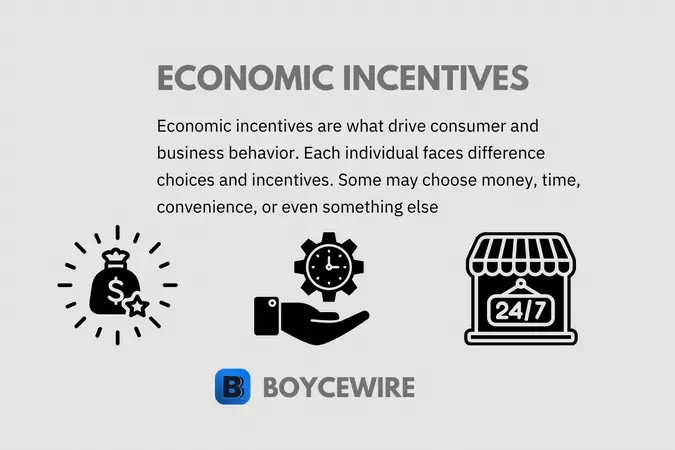Economic Incentives: What it is, Types & Examples

What are Incentives in Economics?
In economics, incentives are what encourages an individual to act in a certain way. In other words, how consumers and businesses respond to market signals such as prices and financial benefits. For instance, if government provides a subsidy to make corn, then farmers have an incentive to do so. After all, they would financially benefit from such an action.
With that said, economic incentives are not just financial. For example, many consumers will want the latest phone, or gadget. The incentive to purchase such goods is partially driven by advertising, but also from other consumers adoption. As other consumers buy the latest iPhone, it can create an incentive for other consumers to do the same. This psychological phenomenon is otherwise known as ‘keeping up with the Joneses’.
Key Points
- An economic incentive is what encourages individuals to pursue one course of action over another.
- There are both financial and non-financial incentives that can affect decision making.
- Economic incentives are used to change behaviour by providing rewards or consequences to the actions of individuals.
We can look at economic incentives as a way by which the consumer’s or businesses’ preferences, wants, or desires are fulfilled or manipulated. Sometimes these are financial, and sometimes they are non-financial.
For example, Mr. Bloggs works 40 hours a week in an office-based role. The overtime rate is set at the same rate as his normal hourly standard which is $20 an hour. At 40 hours, Mr. Bloggs’ preference for his free time and entertainment surpass his preference for additional income. In other words, to work an additional hour, he is no longer incentivized by the same rate of pay.
However, the incentive to Mr. Bloggs’ changes when his firm offers two times his hourly rate. In such a case, the incentives for Mr. Bloggs changes. He is now offered $40 to work an extra hour, which is not considered worth more to him than one hour of his free time.
Positive and Negative Economic Incentives
Positive Economic Incentives
A positive economic incentive is where an individual or business receives something in return for their action. In other words, they are rewarded for acting in a particular way. This creates a motivation for a person or a group of people, to do something they would otherwise be unwilling to do.
If we look at the classic metaphor of the donkey, the carrot, and the stick. The positive incentive for the donkey is the carrot. It is incentivized to move forward in order to gain the reward of the carrot. This is a positive incentive. By contrast, the stick is a punishment, and therefore a negative incentive. There is no gain, but loss and punishment.
How Effective are Positive Incentives?
Positive incentives can work well in motivating people, but they can also be costly and lose their effectiveness over time. For instance, providing subsidies to farms for corn production may motivate them initially, but when the subsidies are removed, their motivation decreases.
Similarly, giving bonuses to employees may encourage them to work harder and more efficiently, but taking away the bonus can have the opposite effect. To maintain the incentive, the positive reward must be continued, which can become expensive if it’s a financial reward.
Additionally, positive incentives can lose their effectiveness as people get used to them. For example, if employees receive the same bonus every year, they can become accustomed to it, and if it’s reduced or eliminated, it can actually decrease motivation.
Overall, the effectiveness of positive incentives depends on the individual and the situation. What motivates one person may not work for another. It’s essential to consider each case separately to determine the best approach.
Negative Economic Incentives
A negative economic incentive is where the individual or business suffers a loss or punishment, in order to encourage a certain behavior or action. In other words, people are incentivized by negative consequences and the fear associated with them. For example, if an employee doesn’t perform, they will get fired. So there is the negative incentive of being fired to incentivize the employee to perform.
Looking at the example of the donkey, carrot, and the stick, the negative incentive is the stick. The stick is used in order to get the donkey to start walking. So the donkey reacts in fear of the stick and walks in order to avoid the negative consequences.
How Effective are Negative Incentives?
The research on incentives is very mixed. Some studies suggest that positive incentives are most effective, whilst others suggest that negative ones are.
The reality of the situation is the impact of that negative and positive incentive on people in different ways. Some are more responsive to negative stimuli, whilst others are more responsive to positive stimuli.
For example, one study showed that younger people were more sensitive to negative stimuli, whilst order people were more sensitive to positive stimuli.
Furthermore, the study found people tended to overestimate their sensitivity to positive stimuli. In other words, people would say they prefer positive stimuli, but responded more favourably to negative stimuli. This doesn’t conclude that negative incentives are best. Rather the effectiveness depends on the individual.
Why are Incentives Important in Economics?
In economics, incentives are important because they can encourage positive outcomes. In other words, economic incentives can be used to reduce economic inefficiencies. For example, a worker that is operating below 100 percent is not producing as much as they could. For both the business and the overall economy, this is suboptimal and economically inefficient.
By introducing an economic incentive, whether a financial bonus or the fear of being fired, the incentive looks to reduce this economic effect and boost output.
With that said, positive incentives may in fact outweigh the economic advantages gained, thereby leading an overall drain on the economy. For example, an employee may earn a bonus of $2,000 but the increased value of their output may only increase by $1,000. So these incentives may not always have the desired result.
1. Influence on Government Policy
When governments look to make policy, they often look at the incentives they create. For instance, they may look to increase and encourage business investment. Now there are several options they could use. Lowering corporation taxes is a direct option, whilst it may look at an in-direct option such as lowering consumer taxes such as the income tax.
Both have different effects and incentives. Putting more money in the hands of the consumer provides them an economic incentive to spend, which could incentivize businesses to invest and expand their output. On the other hand, it may be more effective to give the money straight to businesses through corporation tax cuts.
Each option creates a different incentive and the relevant parties may react differently based on several variables. For instance, a tax cut is going to have a very different impact during a recession than during an economic boom. So governments must consider this in their decision making.
2. Influence on Business
On a smaller scale, economic incentives are important to businesses as they want to get the most out of their employees. If an employee is not performing at 100 percent, the employer will look at how to improve this. The reason may be due to something unrelated to incentives such as inadequate training. However, under-performance may also relate to a lack of incentives. It is important to first identify why this is occurring. For instance, it may be due to poor management or working conditions.
As a result, businesses actively look at how best to incentivize workers to reach their potential. This may involve quarterly performance reviews, so the workers know they are being monitored, which would be classed as a negative incentive as workers fear a loss of their job or face a backlash from management. Alternatively, businesses may look to offer a financial incentive.
3. Influence on Employees
Businesses frequently use economic incentives to help boost employee engagement and productivity. A happy worker is also seen as a productive one. By providing incentives such as bonuses, free health, gym membership, and other fringe benefits, employees will stay motivated.
The idea is to provide employees with additional incentives that may not be available at other firms. In turn, the aim is to provide the employee with the incentive to work hard in order to maintain their position at the firm. In other words, they need to justify that they are worthy of the bonuses and other financial incentives.
However, non-financial incentives are also important to employee wellbeing as well as employee turnover. It’s equally important to have good management with clean and precise direction. It can be demotivating to receive a task without direction and then fail miserably. Equally, a lack of development and career prospects can demotivate. So having a clear career guide and assistance plan for employees can incentivize them to work hard to move up the hypothetical ladder.
4. Influence on Consumers
There are three main factors that incentivize consumers to buy a product. They are price, quality, and brand image. If a business wants to incentivize a consumer to buy its product, it needs to reduce the price – which is a financial incentive. Alternatively, it can increase the quality of the product. If it makes a high-quality product that is superior to its competitors, then consumers will be incentivized to buy its goods.
There is also brand image to consider. Advertising helps in this regard, but also factors such as quality of service and product, as well as consumer reviews. These all contribute to the firm’s brand image which in itself can be a driving factor. For example, consumers trust the likes of Apple to a greater degree than an independent store such as Mike’s Mobiles. By itself, a firm’s brand image can provide an economic incentive – whether it’s to ‘keep up with the Joneses’ or to have a high-quality product that consumers trust.
Types of Incentives
There are two main types of economic incentives which can be split down into financial and non-financial. Examples include:
Financial
1. Bonuses
A large number of businesses offer employees a bonus for meeting yearly targets. Depending on how achievable those targets are, this can create an incentive to work harder to achieve those objectives. For example, this might be to hit X number of sales in the year or increase billable hours to clients.
2. Commission
Commission incentives are usually most prevalent in sales roles. They are incentivized to get more sales as those sales mean higher pay in return. This encourages employees to work tirelessly in order to get those extra sales. As a result, the goals of the business and employees are aligned as both are aiming to maximize the number of sales.
3. Fringe Benefits
Fringe benefits are those financial benefits which the employee may usually have to pay for, but which the employer covers. For instance, firms such as Google cover expenditures such as child care, free housing, and free medical care facilities. All of which saves the employees thousands of dollars and are not offered at competing companies. This helps develop a sense of gratitude to the firm which can incentivize workers.
4. Profit-sharing
Some firms offer a profit-sharing incentive so that employees receive part of the profits. This aligns the incentives of the firm in line with the employee. Whilst the employee will want the firm to do well as their job depends on it, they may not necessarily be motivated to save the firm a few dollars here and there. By employing a profit-sharing incentive, it is now in the employee’s self-interest to ensure the firm is spending and saving money wisely.
5. Suggestion System
Some firms offer a suggestion system whereby employees are financially rewarded for their ideas. These ideas may help the company become more efficient, thereby saving money and increasing profitability.
6. Wage Incentives
Businesses use wage structures to help incentivize employees. This could be by offering a higher wage than competitors. Employees are therefore incentivized to perform as they know they would not be so well compensated in a similar role at a competitor. In the same fashion, an increase in the employee’s wage may increase their satisfaction in their role, thereby providing an incentive and motivation to perform to justify the higher wage.
Non-Financial
1. Appreciation
This is a relatively straight forward and basic incentive, but one that is highly effective. Just a simple thank you or another form of gratitude can go a long way. It can be even more effective if it comes from more senior employees in the firm or those with a degree of authority.
2. Competition
Competition can not only provide an incentive to individuals but also businesses. Businesses have to compete with each other purely in order to survive. That means firms need to constantly focus on efficiencies and maintaining a streamlined process that minimizes costs. Similarly, employees have the same incentives when faced with competition. If they want to move to higher-paid positions, they have to compete with other employees. In turn, they have to justify the promotion.
3. Delegation of Authority
When tasks are delegated, employees will often feel a sense of responsibility – particularly if the task is an important one. In turn, this gives employees a sense of importance as they are entrusted with a crucial task. By delegating such tasks, the employee is given a sense of importance and self-worth – something everyone wants. In turn, employees are incentivized to justify this trust and feeling of importance.
4. Effective Leadership
Sometimes employees are tasked with jobs that they have no idea of what they are doing or the objectives they are expected to achieve. This can be highly de-motivational as employees will feel they have been set up to fail. Instead, effective leadership where employees are trained and know what they are doing with clear instruction can provide an incentive. That incentive is to ‘payback’ the effort and effectiveness of management. It’s easy for employees to fail when they aren’t given clear instruction, but when they are, it is a matter of self-esteem to justify they are capable of the task.
5. Opportunity to Progress
When employees work in a dead-end job, it can be hugely demotivating for workers. For example, the average supermarket worker may seem like they have nowhere to go from being a cashier. However, many supermarkets and other employers try to highlight and encourage potential career paths for such employees to provide an incentive. Some offer management courses that can assist cashiers and the like to move up in supervisorial roles and potentially into regional management.
6. Participation in Decision Making
When management makes decisions that affect the whole workforce, but there is no input from the workers, it can be highly demotivational. Instead, when workers feel part of the discussions, it can provide an incentive as they feel the decisions made were also theirs. For example, this might be the decision to move to a different system or style of working. If that decision is theirs, any negative effects will be partially mitigated.
FAQs on Economic Incentives
In economic, incentives are what encourages people to undertake certain economic activities. For instance, a subsidy may incentivise utility firms to invest in green energy. A bonus may incentivise an employee to put in their full effort to the job in hand.
Incentives are what encourage individuals to take a specific decision, usually that would benefit them. For example, an employee may be offered a bonus for meeting their objectives. Or, a firm may face increased competition so is incentivised to invest in developing new product lines and marketing projects to compete. Other examples of incentives include:
– Commission
– Fringe benefits
– Profit Sharing
– Wage incentives
– Appreciation
– Competition
– Delegation
– Opportunity to progress
– Subsidies
Employee incentives are ways by which a firm aims to increase productivity of its employee. By offering bonuses, commission, fringe benefits, and a friendly working environment, it is seen that workers will become more productive.
Economic incentives can be a useful tool in motivating individuals, usually in order to nudge them into actions that are beneficial to the firm or society. For example, farmers may be offered a subsidy to grow certain type of environmentally friendly crops. There are also other economic incentives such as taxes which can be imposed on goods such as tobacco or alcohol which look to reduce its consumption.
Economic incentives may not always be effective as its implementation can determine its success. For instance, an employee bonus may encourage positive performance behaviour in the short-term. However, in the long-term, if employees become accustomed to it, their performance may drop – particularly if the connect between the two becomes confusing.
About Paul
Paul Boyce is an economics editor with over 10 years experience in the industry. Currently working as a consultant within the financial services sector, Paul is the CEO and chief editor of BoyceWire. He has written publications for FEE, the Mises Institute, and many others.

Related Topics
Further Reading
 How is Inflation Measured - So now we have looked at what money essentially represents, let us look at how inflation is measured. Inflation is…
How is Inflation Measured - So now we have looked at what money essentially represents, let us look at how inflation is measured. Inflation is…  What is Inflation - Inflation is created through excessive money creation. That is to say, money supply is in excess of economic output. Let’s…
What is Inflation - Inflation is created through excessive money creation. That is to say, money supply is in excess of economic output. Let’s…  Floating Exchange Rate: Definition, Pros, Cons & Example - A floating exchange rate is where the value of a nation's currency, when compared to another, is determined by supply…
Floating Exchange Rate: Definition, Pros, Cons & Example - A floating exchange rate is where the value of a nation's currency, when compared to another, is determined by supply… 